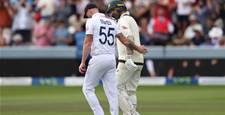With the last two days of the Old Trafford Test wrecked by rain Australia gained the draw they needed to retain The Ashes.
Despite the tied result, the Manchester Test was dominated by England. The impetus of the series had seemingly shifted. Nothing could stop the Manchester weather and, at times, it seemed that Australia couldn’t do anything to hold up a relentless old foe.
With only six second innings wickets left and still trailing by 162 runs the forecast rain arrived on the fourth morning. Only thirty more overs were possible over the final two days and they weren’t enough for England to pull off the win that would have levelled the series.
So, Australia had retained The Ashes but it barely felt like a victory as the momentum had clearly shifted towards England.
Looking back, Australia had pulled off an unlikely win at Edgbaston and then secured a 43 run victory at Lord’s. They found themselves 2-0 up after two tight contests. A draw in any of the last three Tests would be enough to retain the trophy. At that point the record books were being reached for to discover the most convincing series wins in England by an Australian touring team.
Fewer pages were being turned to check for the frequency of comebacks as the thought that England could achieve such a thing against the recently crowned ICC World Test Champions was remote.
Back in 1936-37 Don Bradman’s side managed to recover having lost the first two Tests. It won the remaining three and that remains the only time this has been achieved in Ashes history.
However, it was England that squeezed out a win in the third Test at Headingley. The talk of a clean sweep had to be put to one side. Now, even before the game had started, some of the conversations had turned to the weather that was forecast for the fourth Test.
The Headingley result had swung the momentum of the series according to the bookmakers. They had made the home side favourites to follow up with another victory at Old Trafford.
The UK Met Office, though, was indicating rain on the last two days of the Manchester game. Both captains spoke about the forecast in their pre-game press conferences.
Pat Cummins shrugged off any thought about weather playing a part, “Forecasts aren’t always that accurate. Things change quickly. You go out (to) win it and if there’s a big shift in conditions we need to change the way we think about it.”
Instead of holding any negative thoughts, Ben Stokes could see it even helping his side, “Going into the last game we were two-nil down we knew we had to win that (game). So, I think that helped us a little bit. Maybe, again, with the weather that’s predicted that it might bring more out of us again knowing that we might push the game on even more than we normally do.”
Indeed, England seemed to be inspired.
In Manchester, they became the first side in the series to take complete control of a game. This was highlighted during the twenty-five overs of the middle session of the second day. England stepped up the aggression as they scored 178 runs while losing only Moeen Ali.
Cummins agreed, “It certainly felt that they were in control for some stages. That two hour block in the middle session wasn’t our best.”
It felt as though the whole balance of the series had changed. By the end of day three the weather forecast was just about the only thing being discussed as an England win that would level the series seemed inevitable.
While the change in the weather could only be pondered, it was possible to analyse the change that had occurred out in the middle of the ground.
There are always many factors that decide the outcome of Test matches but, in this case, there were probably two key influences. England welcomed back the pace of Mark Wood and the guile of Chris Woakes. Australia lost Nathan Lyon to injury.
Ollie Robinson and James Anderson had been largely ineffectual in each of their matches. They didn’t seem to have the pace to bother the Australian batters. Now, with Wood in the side, things were very different. When the ball is thrown to Wood the noise level of the crowd lifts and there is a sense of expectation. Sheer pace will always be a potent weapon and Wood provided it.
He was player of the match at Headingley with his extreme pace always a handful as he finished with match figures of 7-100 and contributed 40 lower order runs. In his second over of that match his third delivery to Marnus Labuschagne touched 155 kph.
After England had smashed their way to 592 at Old Trafford it was Wood who stepped up to blast out three of Australia’s top order in the second innings. Short balls, at pace, accounted for Steve Smith and Travis Head.
Woakes took 13 wickets in the same two Tests at an average of only 19.50. He was also there to hit the winning runs as he finished unbeaten on 32 at Headingley.
He doesn’t have the pace of Wood but he nags away with line and length. The movement he gets both ways off the wicket is awkward. He has removed both left and right handers and only one of his twelve wickets has been that of a tail-ender. Steve Smith is the only batter to have been able to see him off successfully.
He is the perfect foil for Wood. If a batter can survive the rockets that Wood sends down then there’s a completely different challenge to face at the other end. Together they unsettle batters.
Stokes recognises the importance of the bowlers working in tandem. “You shouldn’t underestimate when Woody’s bowling as fast as he does that actually the pressure’s always on the batsmen when they face the bowler at the other end as well.”
Since they came into the side the pair has taken 23 of the 35 Australian wickets to fall at an average of 18.30 between them.
Australia have sorely missed Lyon following his injury at Lord’s. Todd Murphy was barely used by Cummins at Headingley and not even picked for Manchester where Australia lined up without a frontline spinner for the first time in over eleven years.
As England chased down the runs in Leeds it seemed that Cummins was reticent to call on the young off-spinner. Had Lyon been there he would have been one of the first bowlers that his captain would have turned to.
Again, in Manchester, when England were going at breakneck speed it would have been Lyon that would have been expected to curb the tide. Instead, all-rounders Mitchell Marsh and Cameron Green along with part-time spinner, Travis Head, had to fill the role.
Green was able to keep things relatively tight and took two wickets. The other two went wicketless with England scoring at nearly seven an over off their bowling.
The Ashes stay with Australia but the question now is whether England can continue their drive and grab a series draw. If they do that by winning the final Test at The Oval then it would be no less than they deserve.
To come back from a two Test deficit and draw an Ashes series is something that England have never done before.
On the other hand, Australia still has the chance of swinging things around again and pulling off an away series Ashes win. A 3-1 series win would be a convincing result. The motivation should still be there as a number of players have said that they have it on their bucket lists and this could be their last opportunity.
Related Articles

Lyon wounded; Lions tamed

Playing From The Tips Ep.112: PGA Championship













